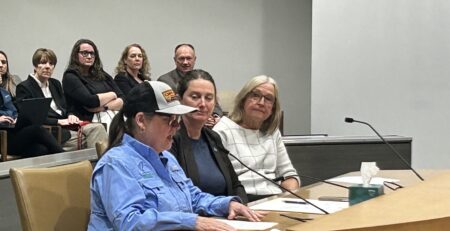Comments needed on Lake Superior management plan by May 8
The deadline for commenting on the DNR’s proposed revision of the management plan for Lake Superior and its tributaries is rapidly approaching.
Comments are due by Sunday May 8.
Here is the link to the webpage, which has draft plan and instructions on how to comment on-line or by phone: http://www.dnr.state.mn.us/lakesuperior/index.html Please note that you can cut and paste comments into the on-line survey, especially into the last box provided with survey item number 13.
The DNR has received very few comments so far and the public record will be skewed toward interest groups who believe quality fishing comes only from stocking programs and is measured only by fish killed. Enlightened anglers who recognize the benefits of managing for wild, self-sustaining populations and limiting harvest to the sustainable surplus to recover populations and ensure long term stability need to speak up now.
Please take a few minutes to submit comments via DNR’s on-line comment survey. Below are several major issues which the DNR needs to hear from you about:
Strongly support DNR’s proposal to cease stocking of lake trout in Lake Superior. Our native lake trout fishery has recovered and naturally reproduced wild fish, not stocking, now supports a high quality fishery. Wild lake trout are best able to maximize the finite productivity of the Lake. Stocking is a tool that is no longer needed for lake trout and in addition to being a waste of money, it can lessen the resilience of the robust wild fishery.
Support the plan’s emphasis on restoring watersheds and habitat. This is the prerequisite to successful coaster brook trout restoration, as well as to improving and maintaining the other wild fisheries in the tributaries and Lake.
Support the overall management goal in the Plan, including its focus on wild, self-sustaining fisheries.
Support DNR’s beaver management approach discussed in the plan and an appendix. The Plan should also have noted that active beaver management is essential to successfully restoring riparian forests, which in turn improves hydrology (base flows) and water temperatures vital to sustaining coldwater fisheries.
Strongly support continuing the catch & release regulation for steelhead. Oppose all attempts to allow steelhead harvest before the kamloops hatchery program has been eliminated, and oppose any steelhead harvest regulation that does not apply uniformly to all Minnesota waters of the Lake Superior or its tributaries, or applies only to certain user groups (such as clients of charter boats).
In response to questions 10 & 11 in the on-line survey, consider making these points:
I strongly support monitoring the population and catch rates. However, I oppose meetings as early as 2020 to discuss possible steelhead harvest, since Kamloops are still being stocked. I can support a limited steelhead harvest once rehabilitation is complete, but any steelhead harvest must be tied to the elimination of the Kamloops stocking program and harvest must be uniform on the Lake and Shore wide and not favor only some angling groups.
Strongly support the steelhead genetics study now underway to determine the negative genetic impacts of stocking domesticated hatchery strain “kamloops” rainbows on wild steelhead.
Urge elimination of or meaningful reduction to the risky “kamloops” stocking program. Straying by these domesticated hatchery strain rainbows into wild steelhead spawning areas continues and kamloops are interfering with wild steelhead reproduction. The extent of the impacts are not yet known, but it threatens to undermine the goal of wild steelhead rehabilitation, and undue years of investment and hard work advancing this goal. The DNR appears unwilling to eliminate this risky program at this time, but it may be willing to make changes. These two changes could be especially helpful:
- Reduce the number of domesticated kamloops stocked (stocking quota) by at least one-third to reduce the number of these hatchery fish straying into steelhead spawning areas and interfering with wild steelhead reproduction.
- Include in the Plan a clearer statement that any discovery of genetic impacts by domesticated kamloops on wild steelhead populations will automatically trigger a reduction of the kamloops stocking quota to the 25,000 yearlings which can be raised entirely at the French River hatchery, and discussions with stakeholders about the possible phase out of this program.
In response to question 9 in the on-line survey, consider making these points:
The kamloops stocking program should be eliminated. It is too risky and threatens to undermine and destroy the wild steelhead fishery.
If the DNR is unwilling to eliminate this program, than it should at least reduce the kamloops stocking quota by 35,000 fish and cease the practice of stocking the kamloops partially raised at Spire Valley at mouth of the French River.
The DNR should only stock the 32,500 kamloops quota in Lester River for so long as it has no evidence of significant straying or negative genetic impacts of kamloops upon wild steelhead. If any such evidence is found, the DNR should immediately and automatically reduce the kamloops stocking quota to just the 25,000 raised entirely at the French River hatchery and initiate discussions with stakeholders about phasing out this hatchery program entirely.
Steelhead fry stocking in the Lester River should be suspended for so long as kamloops are stocked in the Lester River.
A rigorous genetic monitoring plan must be implemented and continue for at least as long as kamloops are stocked in Lake Superior or its tributaries.
Other items you may wish to comment on:
- Coaster brook trout. The on-line survey will ask about keeping the 20” minimum size limit on below barrier brook trout. Consider asking for a higher minimum size in order to ensure a larger spawning population.
- The Habitat chapter focuses too narrowly on channel stability and excludes valuable in-stream habitat. Habitat improvement (“enhancement”) is valuable even where stream channels are relatively stable and full channel restoration is not required. The habitat chapter too narrowly focuses only on channel stability and ignores the fact that past logging activities removed large wood (habitat) from North Shore streams and subsequent forest management has prevented recruitment of large wood to the channel. Many stream reaches which do not require channel restoration nonetheless lack appropriate amounts of large woody habitat. The proposed draft is too dogmatic, limiting TU and others only to full scale restoration and only to the use of undefined natural channel design methodology. It must be revised to acknowledge that habitat is not synonymous with channel stability and allow habitat improvement in degraded reaches which do not require large scale channel restoration.
- Reductions in steelhead fry stocking. Some of the reductions proposed are overdue, including ceasing stocking the Lester River as long as domesticated kamloops are stocked there and eliminating stocking in the Baptism River, where spawning and juvenile rearing habitat is adequate. Ceasing fry stocking in the Cascade River raises concerns for many anglers, since they believe the quality steelheading there is derived in large part from the alternate year fry stocking. The genetic study should help determine the contribution of fry stocking to adult steelhead returns. Members who are concerned that eliminating fry stocking will significantly reduce steelhead returns should voice their concerns now. Additionally/alternatively, members may want to ask that the Plan include a provision calling for resuming fry stocking in the Cascade River (or elsewhere) if steelhead fishing significantly declines there.


